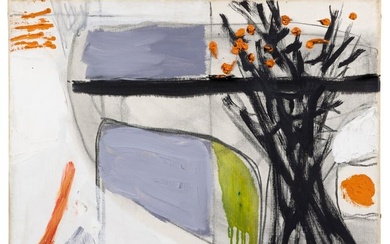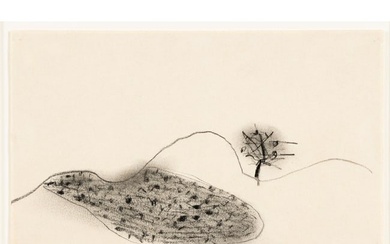§ ROGER HILTON C.B.E. (BRITISH 1911-1975) FIGURE
Signed and dated verso, oil on canvas (Dimensions: 91.5cm x 76cm (36in x 30in))
(91.5cm x 76cm (36in x 30in))
Footnote: Provenance: The New Art Centre, London. Note: Roger Hilton is considered an important pioneer of abstraction in the post-Second World War era of British art, as well as one of its most successful proponents. Marked out as a great talent from an early stage, Hilton studied at the Slade under Henry Tonks between 1929 and 1931 and was the recipient of the Orpen Prize and Slade Scholarship. He went to the Academia Ranson, under Roger Bissière, then to Atelier Colarossi, Paris. On returning to London in 1933, he continued his studies at the prestigious Academy Schools. Very shortly after, he was welcomed to exhibit with the London Group, continuing to do so until 1951. He had a significant retrospective at the ICA in 1958 and in 1963 he won the prestigious first prize at John Moores Exhibition in Liverpool. A year later, he represented Britain at the Venice Biennale, and by 1968 he had been appointed a C.B.E. In all, a stellar trajectory which marks him as one of the most significant Modern British artists of the 20th century. Hilton’s career is famously closely associated with the St Ives School, the coastal seat of Britain’s abstract art movement and answer to the American Abstract Expressionists. Indeed, it was during his first visit to Cornwall in 1950 that he produced his first truly abstract painting; the successful reception of which led to his inclusion in the seminal book Nine Abstract Artists, published in 1954. By 1957 he had moved to Cornwall permanently. Key motifs in his work included abstracted explorations of the landscape and the human form. A larger than life character: quick-tongued, egotistical and a lover of women and alcohol, Hilton’s semi-abstracted/semi-figurative works from the mid-1960s to early-70s, like the example offered here, burst with character. Vital, sexually charged and darkly humorous, it is easy to grasp why this body of works are among the best loved of his career. ‘Figure – 1972’ is one of the last oils the artist painted, before turning to gouache works on a smaller scale; a change incited in the main by his declining health due to the alcoholism that would eventually kill him in 1975. Subsequently recognised as an important work in his oeuvre, ‘Figure – 1972’ has been exhibited at the Tate, and was held for some years in the important Harriman Judd Collection; a pair of Californian connoisseurs who are perhaps best recognised for championing British pottery, including the studio pottery of the St Ives School.
Sale price
Estimate
Time, Location
Auction House
Signed and dated verso, oil on canvas (Dimensions: 91.5cm x 76cm (36in x 30in))
(91.5cm x 76cm (36in x 30in))
Footnote: Provenance: The New Art Centre, London. Note: Roger Hilton is considered an important pioneer of abstraction in the post-Second World War era of British art, as well as one of its most successful proponents. Marked out as a great talent from an early stage, Hilton studied at the Slade under Henry Tonks between 1929 and 1931 and was the recipient of the Orpen Prize and Slade Scholarship. He went to the Academia Ranson, under Roger Bissière, then to Atelier Colarossi, Paris. On returning to London in 1933, he continued his studies at the prestigious Academy Schools. Very shortly after, he was welcomed to exhibit with the London Group, continuing to do so until 1951. He had a significant retrospective at the ICA in 1958 and in 1963 he won the prestigious first prize at John Moores Exhibition in Liverpool. A year later, he represented Britain at the Venice Biennale, and by 1968 he had been appointed a C.B.E. In all, a stellar trajectory which marks him as one of the most significant Modern British artists of the 20th century. Hilton’s career is famously closely associated with the St Ives School, the coastal seat of Britain’s abstract art movement and answer to the American Abstract Expressionists. Indeed, it was during his first visit to Cornwall in 1950 that he produced his first truly abstract painting; the successful reception of which led to his inclusion in the seminal book Nine Abstract Artists, published in 1954. By 1957 he had moved to Cornwall permanently. Key motifs in his work included abstracted explorations of the landscape and the human form. A larger than life character: quick-tongued, egotistical and a lover of women and alcohol, Hilton’s semi-abstracted/semi-figurative works from the mid-1960s to early-70s, like the example offered here, burst with character. Vital, sexually charged and darkly humorous, it is easy to grasp why this body of works are among the best loved of his career. ‘Figure – 1972’ is one of the last oils the artist painted, before turning to gouache works on a smaller scale; a change incited in the main by his declining health due to the alcoholism that would eventually kill him in 1975. Subsequently recognised as an important work in his oeuvre, ‘Figure – 1972’ has been exhibited at the Tate, and was held for some years in the important Harriman Judd Collection; a pair of Californian connoisseurs who are perhaps best recognised for championing British pottery, including the studio pottery of the St Ives School.





